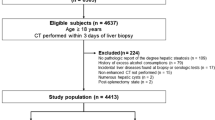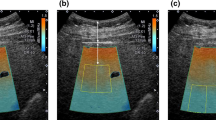Abstract
Objectives
To determine a highly specific liver attenuation threshold at unenhanced CT for biopsy-proven moderate to severe hepatic steatosis (≥30% at histology).
Methods
315 asymptomatic adults (mean age ± SD, 31.5 ± 10.1 years; 207 men, 108 women) underwent same-day unenhanced liver CT and ultrasound-guided liver biopsy. Blinded to biopsy results, CT liver attenuation was measured using standard region-of-interest methodology. Multiple linear regression analysis was used to assess the relationship of CT liver attenuation with patient age, gender, BMI, CT system, and hepatic fat and iron content.
Results
Thirty-nine subjects had moderate to severe steatosis and 276 had mild or no steatosis. A liver attenuation threshold of 48 HU was 100% specific (276/276) for moderate to severe steatosis, with no false-positives. Sensitivity, PPV and NPV at this HU threshold was 53.8%, 100% and 93.9%. Hepatic fat content was the overwhelming determinant of liver attenuation values, but CT system (P < 0.001), and hepatic iron (P = 0.035) also had a statistically significant independent association.
Conclusions
Unenhanced CT liver attenuation alone is highly specific for moderate to severe hepatic steatosis, allowing for confident non-invasive identification of large retrospective/prospective cohorts for natural history evaluation of incidental non-alcoholic fatty liver disease. Low sensitivity, however, precludes effective population screening at this threshold.
Key Points
• Unenhanced CT liver attenuation is highly specific for diagnosing moderate/severe hepatic steatosis.
• Unenhanced CT can identify large cohorts for epidemiological studies of incidental steatosis.
• Unenhanced CT is not, however, effective for population screening for hepatic steatosis.


Similar content being viewed by others
References
Boyce CJ, Pickhardt PJ, Kim DH et al (2010) Hepatic steatosis (fatty liver disease) in asymptomatic adults identified by unenhanced low-dose CT. AJR Am J Roentgenol 194:623–628
Browning JD, Szczepaniak LS, Dobbins R et al (2004) Prevalence of hepatic steatosis in an urban population in the United States: impact of ethnicity. Hepatology 40:1387–1395
Byron D, Minuk GY (1996) Clinical hepatology: profile of an urban, hospital-based practice. Hepatology 24:813–815
Clark JM, Brancati FL, Diehl AM (2003) The prevalence and etiology of elevated aminotransferase levels in the United States. Am J Gastroenterol 98:960–967
Hilden M, Christoffersen P, Juhl E et al (1977) Liver histology in a ‘normal’ population–examinations of 503 consecutive fatal traffic casualties. Scand J Gastroenterol 12:593–597
Kammen BF, Pacharn P, Thoeni RF et al (2001) Focal fatty infiltration of the liver: analysis of prevalence and CT findings in children and young adults. AJR Am J Roentgenol 177:1035–1039
Park SH, Jeon WK, Kim SH et al (2006) Prevalence and risk factors of non-alcoholic fatty liver disease among Korean adults. J Gastroenterol Hepatol 21:138–143
Angulo P (2002) Nonalcoholic fatty liver disease. N Engl J Med 346:1221–1231
Dunn W, Xu R, Wingard DL et al (2008) Suspected nonalcoholic fatty liver disease and mortality risk in a population-based cohort study. Am J Gastroenterol 103:2263–2271
Marchesini G, Bugianesi E, Forlani G et al (2003) Nonalcoholic fatty liver, steatohepatitis, and the metabolic syndrome. Hepatology 37:917–923
Ong JP, Pitts A, Younossi ZM (2008) Increased overall mortality and liver-related mortality in non-alcoholic fatty liver disease. J Hepatol 49:608–612
Vuppalanchi R, Chalasani N (2009) Nonalcoholic fatty liver disease and nonalcoholic steatohepatitis: selected practical issues in their evaluation and management. Hepatology 49:306–317
Brunt EM, Janney CG, Di Bisceglie AM et al (1999) Nonalcoholic steatohepatitis: a proposal for grading and staging the histological lesions. Am J Gastroenterol 94:2467–2474
Hourigan LF, Macdonald GA, Purdie D et al (1999) Fibrosis in chronic hepatitis C correlates significantly with body mass index and steatosis. Hepatology 29:1215–1219
Kleiner DE, Brunt EM, Van Natta M et al (2005) Design and validation of a histological scoring system for nonalcoholic fatty liver disease. Hepatology 41:1313–1321
Petta S, Camma C, Di Marco V et al (2011) Hepatic steatosis and insulin resistance are associated with severe fibrosis in patients with chronic hepatitis caused by HBV or HCV infection. Liver Int 31:507–515
Selzner M, Clavien PA (2001) Fatty liver in liver transplantation and surgery. Semin Liver Dis 21:105–113
Angulo P (2010) Long-term mortality in nonalcoholic fatty liver disease: is liver histology of any prognostic significance? Hepatology 51:373–375
Angulo P (2011) Diagnosing steatohepatitis and predicting liver-related mortality in patients with NAFLD: two distinct concepts. Hepatology 53:1792–1794
Adams LA, Lymp JF, St Sauver J et al (2005) The natural history of nonalcoholic fatty liver disease: a population-based cohort study. Gastroenterology 129:113–121
Dam-Larsen S, Franzmann M, Andersen IB et al (2004) Long term prognosis of fatty liver: risk of chronic liver disease and death. Gut 53:750–755
Ekstedt M, Franzen LE, Mathiesen UL et al (2006) Long-term follow-up of patients with NAFLD and elevated liver enzymes. Hepatology 44:865–873
Teli MR, James OF, Burt AD, Bennett MK, Day CP (1995) The natural history of nonalcoholic fatty liver: a follow-up study. Hepatology 22:1714–1719
McKimmie RL, Daniel KR, Carr JJ et al (2008) Hepatic steatosis and subclinical cardiovascular disease in a cohort enriched for type 2 diabetes: the Diabetes Heart Study. Am J Gastroenterol 103:3029–3035
Chalasani N, Wilson L, Kleiner DE et al (2008) Relationship of steatosis grade and zonal location to histological features of steatohepatitis in adult patients with non-alcoholic fatty liver disease. J Hepatol 48:829–834
Kodama Y, Ng CS, Wu TT et al (2007) Comparison of CT methods for determining the fat content of the liver. AJR Am J Roentgenol 188:1307–1312
Lee SS, Park SH, Kim HJ et al (2010) Non-invasive assessment of hepatic steatosis: prospective comparison of the accuracy of imaging examinations. J Hepatol 52:579–585
Park SH, Kim PN, Kim KW et al (2006) Macrovesicular hepatic steatosis in living liver donors: use of CT for quantitative and qualitative assessment. Radiology 239:105–112
Park YS, Park SH, Lee SS et al (2011) Biopsy-proven nonsteatotic liver in adults: estimation of reference range for difference in attenuation between the liver and the spleen at nonenhanced CT. Radiology 258:760–766
Speliotes EK, Massaro JM, Hoffmann U et al (2008) Liver fat is reproducibly measured using computed tomography in the Framingham Heart Study. J Gastroenterol Hepatol 23:894–899
LeSage GD, Baldus WP, Fairbanks VF et al (1983) Hemochromatosis: genetic or alcohol-induced? Gastroenterology 84:1471–1477
Strauss S, Gavish E, Gottlieb P et al (2007) Interobserver and intraobserver variability in the sonographic assessment of fatty liver. AJR Am J Roentgenol 189:W320–323
Guiu B, Loffroy R, Cercueil JP et al (2008) Multiecho MR imaging and proton MR spectroscopy for liver fat quantification. Radiology 249:1081
Hines CD, Frydrychowicz A, Hamilton G et al (2011) T(1) independent, T(2) (*) corrected chemical shift based fat-water separation with multi-peak fat spectral modeling is an accurate and precise measure of hepatic steatosis. J Magn Reson Imaging 33:873–881
Meisamy S, Hines CD, Hamilton G et al (2011) Quantification of hepatic steatosis with T1-independent, T2-corrected MR imaging with spectral modeling of fat: blinded comparison with MR spectroscopy. Radiology 258:767–775
Yokoo T, Bydder M, Hamilton G et al (2009) Nonalcoholic fatty liver disease: diagnostic and fat-grading accuracy of low-flip-angle multiecho gradient-recalled-echo MR imaging at 1.5 T. Radiology 251:67–76
Fischer MA, Gnannt R, Raptis D et al (2011) Quantification of liver fat in the presence of iron and iodine: an ex-vivo dual-energy CT study. Invest Radiol 46:351–358
Bydder GM, Kreel L, Chapman RW et al (1980) Accuracy of computed tomography in diagnosis of fatty liver. Br Med J 281:1042
Piekarski J, Goldberg HI, Royal SA et al (1980) Difference between liver and spleen CT numbers in the normal adult: its usefulness in predicting the presence of diffuse liver disease. Radiology 137:727–729
Kim DY, Park SH, Lee SS et al (2010) Contrast-enhanced computed tomography for the diagnosis of fatty liver: prospective study with same-day biopsy used as the reference standard. Eur Radiol 20:359–366
Lee SW, Park SH, Kim KW et al (2007) Unenhanced CT for assessment of macrovesicular hepatic steatosis in living liver donors: comparison of visual grading with liver attenuation index. Radiology 244:479–485
Limanond P, Raman SS, Lassman C et al (2004) Macrovesicular hepatic steatosis in living related liver donors: correlation between CT and histologic findings. Radiology 230:276–280
Oliva MR, Mortele KJ, Segatto E et al (2005) Computed tomography features of nonalcoholic steatohepatitis with histopathologic correlation. J Comput Assist Tomogr 30:37–43
Yoshimitsu K, Kuroda Y, Nakamuta M et al (2008) Noninvasive estimation of hepatic steatosis using plain CT vs. chemical-shift MR imaging: significance for living donors. J Magn Reson Imaging 28:678–684
Birnbaum BA, Hindman N, Lee J et al (2007) Multi-detector row CT attenuation measurements: assessment of intra- and interscanner variability with an anthropomorphic body CT phantom. Radiology 242:109–119
Sande EP, Martinsen AC, Hole EO et al (2010) Interphantom and interscanner variations for Hounsfield units–establishment of reference values for HU in a commercial QA phantom. Phys Med Biol 55:5123–5135
Cakir B, Kirbas I, Demirhan B et al (2009) Fulminant hepatic failure in children: etiology, histopathology and MDCT findings. Eur J Radiol 72:327–334
Shakil AO, Jones BC, Lee RG et al (2000) Prognostic value of abdominal CT scanning and hepatic histopathology in patients with acute liver failure. Dig Dis Sci 45:334–339
Saadeh S, Younossi ZM, Remer EM et al (2002) The utility of radiological imaging in nonalcoholic fatty liver disease. Gastroenterology 123:745–750
Author information
Authors and Affiliations
Corresponding author
Rights and permissions
About this article
Cite this article
Pickhardt, P.J., Park, S.H., Hahn, L. et al. Specificity of unenhanced CT for non-invasive diagnosis of hepatic steatosis: implications for the investigation of the natural history of incidental steatosis. Eur Radiol 22, 1075–1082 (2012). https://doi.org/10.1007/s00330-011-2349-2
Received:
Revised:
Accepted:
Published:
Issue Date:
DOI: https://doi.org/10.1007/s00330-011-2349-2




